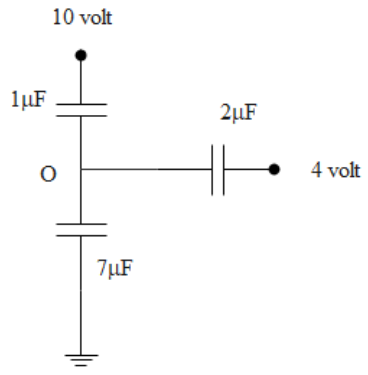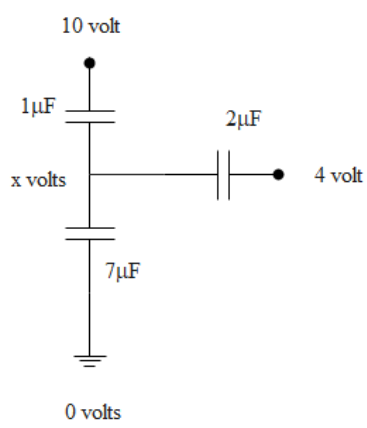
Three capacitors are connected as shown in the figure. The potential at point 0 is equal to

A. 1.4 volt
B. 4.7 volt
C. Zero
D. 1.8 volt

Answer
589.5k+ views
Hint: To solve this question we need to have an idea about the concept of nodal analysis. With the help of the nodal analysis concept we will be able to find the potential at O for the three capacitors. The diagram plays a very important role for this question. It gives us an idea about the position of the capacitors placed in the circuit.
Complete step-by-step answer:
Nodal analysis is a method which is used to analyse the circuits on the basis of defining node voltages as the variables. The technique of nodal analysis can be used to analyse the circuits on the basis of the reactive components. With reference to the above diagram, we can determine that there are a total of 3 capacitors from the node point O. We can consider the voltage at the node point to be x as is shown in the figure below.

We can see the net charge to be the product of capacitance and voltage.
$\text{Q=CV}$
Where, Q = charge
C = capacitance
V = voltage
Therefore, the summation of the charges flowing through the transmission lines is zero. Hence, we get an equation,
$7(\text{x}-0)\text{ + 1(x}-\text{10) + 2(x}-\text{4) = 0}$
$\Rightarrow \text{ 10x = 18}$
$\Rightarrow \text{ x = 1}\text{.8V}$
Therefore, the correct option is Option D.
Note: No doubt that nodal analysis is a very used method. However, it has got some limitations as well. Some of the limitations include the inability to work with voltage sources and the current dependent elements of the circuits in a simple and efficient manner.
Complete step-by-step answer:
Nodal analysis is a method which is used to analyse the circuits on the basis of defining node voltages as the variables. The technique of nodal analysis can be used to analyse the circuits on the basis of the reactive components. With reference to the above diagram, we can determine that there are a total of 3 capacitors from the node point O. We can consider the voltage at the node point to be x as is shown in the figure below.

We can see the net charge to be the product of capacitance and voltage.
$\text{Q=CV}$
Where, Q = charge
C = capacitance
V = voltage
Therefore, the summation of the charges flowing through the transmission lines is zero. Hence, we get an equation,
$7(\text{x}-0)\text{ + 1(x}-\text{10) + 2(x}-\text{4) = 0}$
$\Rightarrow \text{ 10x = 18}$
$\Rightarrow \text{ x = 1}\text{.8V}$
Therefore, the correct option is Option D.
Note: No doubt that nodal analysis is a very used method. However, it has got some limitations as well. Some of the limitations include the inability to work with voltage sources and the current dependent elements of the circuits in a simple and efficient manner.
Recently Updated Pages
A man running at a speed 5 ms is viewed in the side class 12 physics CBSE

The number of solutions in x in 02pi for which sqrt class 12 maths CBSE

State and explain Hardy Weinbergs Principle class 12 biology CBSE

Write any two methods of preparation of phenol Give class 12 chemistry CBSE

Which of the following statements is wrong a Amnion class 12 biology CBSE

Differentiate between action potential and resting class 12 biology CBSE

Trending doubts
What are the major means of transport Explain each class 12 social science CBSE

Which are the Top 10 Largest Countries of the World?

Draw a labelled sketch of the human eye class 12 physics CBSE

Explain sex determination in humans with line diag class 12 biology CBSE

Explain sex determination in humans with the help of class 12 biology CBSE

Differentiate between homogeneous and heterogeneous class 12 chemistry CBSE




